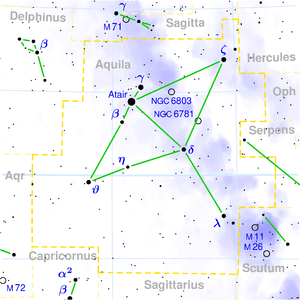Beta Aquilae
 Location of Beta Aquilae to the upper left of center | |
| Observation data Epoch J2000 Equinox J2000 | |
|---|---|
| Constellation | Aquila |
| Right ascension | 19h 55m 18.8s |
| Declination | +06° 24′ 24″ |
| Apparent magnitude (V) | 3.71/11.4 |
| Characteristics | |
| Spectral type | G8 IVvar |
| U−B color index | 0.48 |
| B−V color index | 0.86 |
| R−I color index | 0.49 |
| Variable type | Suspected |
| Astrometry | |
| Radial velocity (Rv) | -40.3 km/s |
| Proper motion (μ) | RA: 46.35 mas/yr Dec.: -481.32 mas/yr |
| Parallax (π) | 72.95 ± 0.83 mas |
| Distance | 44.7 ± 0.5 ly (13.7 ± 0.2 pc) |
| Details | |
| Mass | 1.26 ± 0.18[1] M☉ |
| Radius | 3.28 ± 0.15[2] R☉ |
| Luminosity | 6.0 ± 0.3[2] L☉ |
| Surface gravity (log g) | 3.60[2] cgs |
| Temperature | 5,100[2] K |
| Metallicity [Fe/H] | –0.30[2] dex |
| Rotational velocity (v sin i) | 0.9[1] km/s |
| Age | 9.6–11.4[3] Gyr |
| Other designations | |
| Database references | |
| SIMBAD | data |
| ARICNS | data |
| Data sources: | |
| Hipparcos Catalogue, CCDM (2002), Bright Star Catalogue (5th rev. ed.) | |
Beta Aquilae (β Aquilae, abbreviated Beta Aql, β Aql), also named Alshain,[4] is a star in the constellation of Aquila.
It has magnitude 3.71 and is of spectral class G8IV. It has a very low level of surface magnetic activity and may be in a state similar to a Maunder minimum.[5] Since 1943, the spectrum of this star has served as one of the stable anchor points by which other stars are classified.[6] It is approximately 44.7 light years from Earth. It has a 12th magnitude optical companion, Beta Aquilae B, which is 13 arcseconds away in the sky.
Nomenclature
β Aquilae (Latinised to Beta Aquilae) is the star's Bayer designation.
It bore the traditional name Alshain derived from the Perso-Arabic term الشاهين aš-šāhīn "the (peregrine) falcon", perhaps by folk etymology from the Persian šāhīn tarāzū (or possibly šāhīn tara zed; see Gamma Aquilae), the Persian name for the asterism α, β and γ Aquilae. In 2016, the International Astronomical Union organized a Working Group on Star Names (WGSN)[7] to catalogue and standardize proper names for stars. The WGSN approved the name Alshain for this star on 21 August 2016 and it is now so entered in the IAU Catalog of Star Names.[4]
In the catalogue of stars in the Calendarium of Al Achsasi al Mouakket, this star was designated Unuk al Ghyrab (عنق ألغراب - únuq al-ghuraab), which was translated into Latin as Collum Corvi, meaning the crow's neck.[8]
In Chinese, 河鼓 (Hé Gŭ), meaning River Drum, refers to an asterism consisting of Beta Aquilae, Altair and Gamma Aquilae.[9] Consequently, Beta Aquilae itself is known as 河鼓一 (Hé Gŭ yī, English: the First Star of River Drum.)[10]
Namesake
USS Alshain (AKA-55) was a United States navy ship.
In culture
In Chinese mythology, The Princess and the Cowherd, this star and Gamma Aquilae, are children of Niulang (牛郎, The Cowherd, Altair) and Zhinü (織女, The Princess, Vega).
The Koori people of Victoria knew Alshain and Gamma Aquilae as the black swan wives of Bunjil (Altair), the wedge-tailed eagle.[11]
See also
References
- 1 2 Bruntt, H.; et al. (July 2010), "Accurate fundamental parameters for 23 bright solar-type stars", Monthly Notices of the Royal Astronomical Society, 405 (3): 1907–1923, arXiv:1002.4268
 , Bibcode:2010MNRAS.405.1907B, doi:10.1111/j.1365-2966.2010.16575.x
, Bibcode:2010MNRAS.405.1907B, doi:10.1111/j.1365-2966.2010.16575.x - 1 2 3 4 5 Piau, L.; et al. (February 2011), "Surface convection and red-giant radius measurements", Astronomy and Astrophysics, 526: A100, arXiv:1010.3649
 , Bibcode:2011A&A...526A.100P, doi:10.1051/0004-6361/201014442
, Bibcode:2011A&A...526A.100P, doi:10.1051/0004-6361/201014442 - ↑ Mamajek, Eric E.; Hillenbrand, Lynne A. (November 2008), "Improved Age Estimation for Solar-Type Dwarfs Using Activity-Rotation Diagnostics", The Astrophysical Journal, 687 (2): 1264–1293, arXiv:0807.1686
 , Bibcode:2008ApJ...687.1264M, doi:10.1086/591785
, Bibcode:2008ApJ...687.1264M, doi:10.1086/591785 - 1 2 "IAU Catalog of Star Names". Retrieved 28 July 2016.
- ↑ Andretta, V.; et al. (February 2005), "The Ca II Infrared Triplet as a stellar activity diagnostic . I. Non-LTE photospheric profiles and definition of the RIRT indicator", Astronomy and Astrophysics, 430: 669−677, Bibcode:2005A&A...430..669A, doi:10.1051/0004-6361:20041745.
- ↑ Garrison, R. F. (December 1993), "Anchor Points for the MK System of Spectral Classification", Bulletin of the American Astronomical Society, 25: 1319, Bibcode:1993AAS...183.1710G, retrieved 2012-02-04
- ↑ IAU Working Group on Star Names (WGSN), International Astronomical Union, retrieved 22 May 2016.
- ↑ Knobel, E. B. (June 1895). "Al Achsasi Al Mouakket, on a catalogue of stars in the Calendarium of Mohammad Al Achsasi Al Mouakket". Monthly Notices of the Royal Astronomical Society. 55: 429. Bibcode:1895MNRAS..55..429K. doi:10.1093/mnras/55.8.429.
- ↑ (Chinese) 中國星座神話, written by 陳久金. Published by 台灣書房出版有限公司, 2005, ISBN 978-986-7332-25-7.
- ↑ (Chinese) 香港太空館 - 研究資源 - 亮星中英對照表, Hong Kong Space Museum. Accessed on line November 26, 2008.
- ↑ Mudrooroo (1994). Aboriginal mythology : an A-Z spanning the history of aboriginal mythology from the earliest legends to the present day. London: HarperCollins. p. 4. ISBN 1-85538-306-3.
External links
- ARICNS
- Beta Aquilae by Professor Jim Kaler.
- Image β Aquilae